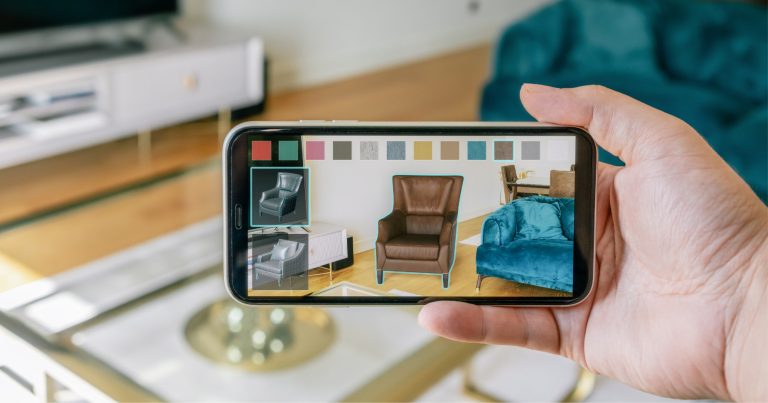When buying online, customers want to know how a product will fit into their lives. How will this couch look in my living room? Does this lipstick flatter my skin tone? How will this dress hug my curves?
Communicating those answers online has traditionally been a challenge—there’s only so much still photos and descriptions can capture. With AR—augmented reality—customers can access a 3D rendering of a product, like a couch, and use their phone’s camera to virtually place that object in their living room. Using AR they can see if the size and style are the right fit. AR can also be used for beauty and fashion products, to place items like lipstick right on your face using selfie mode. Given how the pandemic has pushed retail online, these experiences are more appealing than ever.
“It just solves some really obvious pain points that have existed in ecommerce forever,” says Russ Maschmeyer, Shopify’s Product Lead for AR in the Shop app. He helps brands seamlessly add AR experiences to their shops.
We’re entering into this phase where we get to experience these products, on our face, in our home, in our environment, on our body, in these ways that actually bring us kind of full circle back to the experience we used to have when we would go visit stores in person.
Russ Maschmeyer
“Except now it’s so much better, because instead of seeing that couch in a showroom, you can actually see it in your living room, where it’s going to end up.”
How brands are winning with AR
The ability to view products in 3D is a big boost for conversion, too. When fashion brand Rebecca Minkof experimented with 3D models, for example, it learned that:
Shoppers were 44% more likely to add an item to their cart after interacting with it in 3D
Customers were 27% more likely to place an order after interacting with a product in 3D
Visitors were 65% more likely to place an order after interacting with a product in AR
AR not only allows customers to see exactly how an item will fit into their lifestyle, it can also be a very practical tool. For large items, like dog kennels from Gunners Kennels, AR lets customers see if they’re choosing the right size for their pet and their home by actually showing how it looks in a room.
When Gunners added AR, it saw:
a 3% increase in cart conversion rate
a 40% increase in order conversion rate
a 5% reduction in return rate
Higher conversion combined with a lower return rate means a boost for your bottom line.
Russ also says that the move away from shopping in browsers to shopping in mobile apps means more sophisticated computing power that can handle experiences like AR with ease.
While this technology feels very new, the tools to create AR experiences are readily available.
What’s pushing the AR trend
The convergence of changing shopping habits and newly available technology has made AR a particularly relevant and engaging ecommerce tool.
The pandemic means we’re shopping from home
Shopping used to only mean going into a store in person and getting to try something on, or measure something, or at least getting up close and personal with a purchase.
But then there was a big shift to online and curbside shopping during the pandemic, which meant having to evaluate a purchase on images and descriptions alone. Even when we could shop in person, things were different, with changing rooms being closed and the option to sample products like cosmetics off the table.
This is where AR can fill the gap. For example, when using high-end waste bin makers Simplehuman’s mobile site, you can simply click to place that item right in your home using your phone. No guesswork, just a clear view of how something as simple as a waste bin will match your home’s aesthetic.
A new generation of shoppers
In a recent report from Snapchat, the app found that 93% of Snapchat users—a customer base dominated by the Gen Z demographic—are interested in using AR for shopping. As well, Snapchatters are 1.6 times more likely than non-Snapchatters to have used AR to try on makeup or clothes.
Being a platform that supports AR use, Snapchat has a financial stake in boosting AR, but it’s also a proven conversion booster for brands.
“This is a generation that has grown up not only with technology, but with mobile phones their entire lives,” says Russ.
“I think people are just discovering how effective AR can be in helping them make faster decisions [and] better decisions about what they buy and bring into their lives.”
Easier access to technology
While it looks complex, it’s easier than ever to add 3D renderings and even AR into your own shop. The first step is always creating a 3D rendering, which can boost conversion even before using it for AR.
Sam Goodwin and Richard Deane started MYPadL to make one thing and make it really well—customized “banz. These silicone bands for pickleball paddles help ensure you never forget which one is yours. On the brand’s website, you can customize a 3D rendering of a banz so you’ll know exactly what you’re getting.
MyPadL’s customizable 3D rendering.
While Sam and Richard knew they wanted a 3D model, neither of them had the expertise to build one. The good news is that Shopify’s core themes, by default, are able to display 3D renderings. You simply upload the model’s file as you would with a still image. For custom themes, the option can be added. And getting that model built is getting easier, too.
“That was the big, worrisome thing for us,” says Sam. “I’m not a website builder, Richard is certainly not a website builder. But we [sought] help.”
They used the Shopify App Store to find Angle 3D Configurator, which specializes in 3D modelling and AR was able to walk them through the whole process and provide the end result. You can also find help by searching for Shopify Experts. Getting that help meant Richard and Sam were able to include a customizable 3D rendering, even without having technical expertise themselves.
It takes some investment to get 3D models ready, but Russ said even the cost of those has dropped over time, from thousands to hundreds of dollars.
Sam says the 3D model has had an impact on their conversion rate, too.
“I think Richard will probably agree that that 3D modeling component does lend itself to that. It’s not generic,” he says.
The next step for MYPadL is to use that 3D model in an AR application, which Shopify is also built to handle. If you’re just getting started, it makes sense to first focus on your core products, measure the impact, and expand from there.
“The ROI on that is essentially unquestionable at this point, and super exciting for merchants and for buyers,” says Russ.
Ready to create your business? Start your free trial of Shopify—no credit card required.
Augmented Reality in Ecommerce FAQ
How is augmented reality used in ecommerce?
Augmented reality (AR) is being used in ecommerce to provide customers with a more interactive and immersive shopping experience. For example, many retail stores are now using AR technology to allow customers to virtually “try on” clothes or accessories before they make a purchase. Similarly, AR can also be used to provide customers with a virtual tour of a store or product before they make a purchase. AR can also be used to provide helpful product information and tutorials to customers, as well as to create interactive advertisements and marketing materials.
Is augmented reality technology an effective tool for e commerce?
Yes, augmented reality technology can be an effective tool for e-commerce. Augmented reality technology can be used to help shoppers visualize products from different angles and perspectives. This allows customers to make more informed decisions on their purchases. Additionally, it can help e-commerce businesses create a more immersive shopping experience with the ability to virtually try on clothes or visualize how furniture would look in a living space. This technology can be used to improve the customer experience and increase conversions.
What is augmented reality shopping?
Augmented reality shopping is an emerging technology that combines the physical and virtual worlds to create an enhanced shopping experience for consumers. It allows customers to virtually interact with products in a physical setting, enabling them to view, manipulate and purchase items without ever leaving their homes. This technology can be used to create immersive shopping experiences that increase customer engagement and satisfaction.
What is virtual reality and how it is used in e commerce?
Virtual reality (VR) is an interactive computer-generated experience that simulates a real-world environment. It can be used to create immersive, interactive, and lifelike experiences for e-commerce customers. VR technology can be utilized to allow customers to virtually explore a store, browse and compare products, customize items, and even take virtual tours of products before purchasing them. It can also be used to create virtual showrooms and interactive product demonstrations. By allowing customers to interact with products in a more immersive way, e-commerce companies can provide a more engaging and personalized shopping experience.






0 Comments